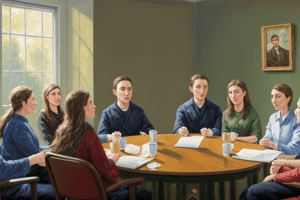Podcast
Questions and Answers
What is the fencing response?
What is the fencing response?
- A type of spinal injury caused by compressive forces
- A protective fencing stance taken by athletes to avoid head injuries
- A type of concussion caused by excessive force to the neck
- A neurological reflex that occurs after a head injury, causing the arms to extend and the hands to flex inward (correct)
What is water hammer?
What is water hammer?
- A type of injury caused by a hammer hitting the head
- A type of concussion caused by water sports
- A type of injury caused by water hitting the head
- A condition where there is an abnormal sound in water pipes due to sudden changes in pressure (correct)
Which type of force is bad for the brain?
Which type of force is bad for the brain?
- Oblique force
- Both B and C (correct)
- Sagittal plane impact
- Lateral force
Which type of forces are bad for the brain?
Which type of forces are bad for the brain?
What is autonomic dysfunction?
What is autonomic dysfunction?
What is autonomic dysfunction?
What is autonomic dysfunction?
What are some red flags for concussion?
What are some red flags for concussion?
What are some red flags for concussion?
What are some red flags for concussion?
What is the normal shape of the C spine?
What is the normal shape of the C spine?
Which part of the spine are children more likely to sustain neck injuries in?
Which part of the spine are children more likely to sustain neck injuries in?
Flashcards are hidden until you start studying
Study Notes
- Water hammer is not mentioned in the text.
- Concussion is an injury to the brain caused by impact resulting in neurological deficits.
- Sports-related concussion is hard to diagnose as symptoms are not always consistent.
- Lateral and oblique forces are bad for the brain, while sagittal plane impact is better due to shear modulus.
- The fencing response hints at damage to the brainstem.
- Autonomic dysfunction is a dysfunction in the regulation of the parasympathetic and sympathetic nervous system.
- Red flags for concussion include headache, dizziness, nausea, vomiting, increased symptoms or severity, and seizures.
- Facet joints in spinal joints help with compressive forces up to 50%.
- The normal shape of the C spine is lordosis, and a breakdown in that shape can occur with axial loading and compression forces with neck flexion.
- Children are more likely to sustain neck injuries in C1-4 as their head is much larger in proportion to their neck.
Studying That Suits You
Use AI to generate personalized quizzes and flashcards to suit your learning preferences.



